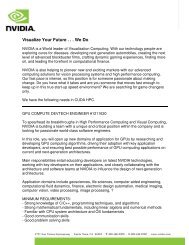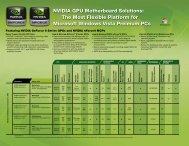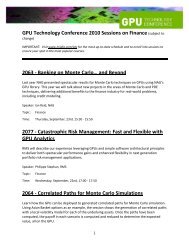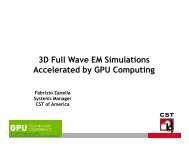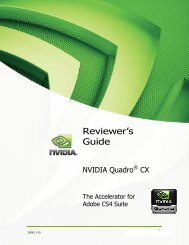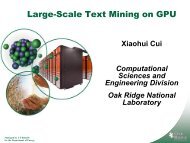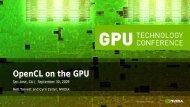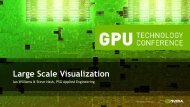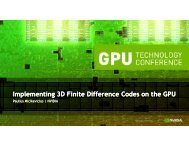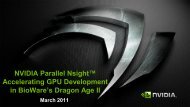Using the GPU to Create a Seamless Display from Multiple Projectors
Using the GPU to Create a Seamless Display from Multiple Projectors
Using the GPU to Create a Seamless Display from Multiple Projectors
You also want an ePaper? Increase the reach of your titles
YUMPU automatically turns print PDFs into web optimized ePapers that Google loves.
<strong>Using</strong> <strong>the</strong> <strong>GPU</strong> <strong>to</strong> <strong>Create</strong> a<br />
<strong>Seamless</strong> <strong>Display</strong> <strong>from</strong> <strong>Multiple</strong><br />
Projec<strong>to</strong>rs<br />
Steve Nash, Nvidia<br />
Paul Green, Scalable <strong>Display</strong>s
Agenda<br />
The Problem -- what do we mean by seamless?<br />
The way it’s been done up until now<br />
Our solution<br />
Scalable <strong>Display</strong>’s implementation
The Problem<br />
Increases in pixel density and <strong>to</strong>tal pixels have not kept pace<br />
with increases in CPU and <strong>GPU</strong> power<br />
Different solutions for adding more pixels<br />
LCDs: obtrusive bezels in <strong>the</strong> way<br />
Nearly bezel-less
The Problem (cont’d)<br />
Projec<strong>to</strong>rs: overlap <strong>the</strong> edges <strong>to</strong> hide <strong>the</strong> seam
The Problem (cont’d)<br />
Projec<strong>to</strong>rs: optics (and screens) are never perfect
The Problem (cont’d)<br />
Just creating <strong>the</strong> overlap makes a hot spot since <strong>the</strong> overlap<br />
region gets twice <strong>the</strong> light
The Problem (cont’d)<br />
Projec<strong>to</strong>rs: how <strong>to</strong> project on domes and curved screens?
Working with <strong>Multiple</strong> Projec<strong>to</strong>rs<br />
Current Nvidia SLI Mosaic product lets you specify overlap<br />
To be truly seamless, need <strong>to</strong> account for geometry and<br />
brightness differences between projec<strong>to</strong>rs
The Solution<br />
Warp & Blend<br />
Warp = Geometry Corrections<br />
Blend = Intensity adjustments<br />
Can do one or <strong>the</strong> o<strong>the</strong>r, or both
The way it’s been done up until now<br />
Hardware appliance for warp and intensity adjustment<br />
Expensive<br />
Extra performance delay tax on <strong>the</strong> display pipeline<br />
Additional complexity<br />
Software warp and intensity adjustment<br />
Applications need <strong>to</strong> be written <strong>to</strong> manage<br />
There has not been an easy way <strong>to</strong> implement this for any application,<br />
until now…
NVIDIA’s Solution<br />
We can do this on <strong>the</strong> <strong>GPU</strong>!<br />
<strong>GPU</strong>s are fast, and are already have <strong>the</strong> pixel information<br />
Perform <strong>the</strong> transformation in <strong>the</strong> display pipeline before <strong>the</strong> pixels get<br />
scanned out<br />
By doing this on <strong>the</strong> <strong>GPU</strong>, we have more flexibility: high quality filtering,<br />
integration with SLI Mosaic, etc.
NVIDIA’s Solution<br />
Works on Quadro 5000, 6000, and Quadro Plex 7000<br />
Use it with G-sync <strong>to</strong> get synchronization between displays
How’s it Done: Work Flow<br />
Take picture of<br />
calibration pattern<br />
<strong>Create</strong> warping mesh<br />
based on picture of<br />
calibration pattern<br />
relative <strong>to</strong> true image<br />
Typical Warping<br />
Mesh contains 1-10K<br />
vertices
How’s it Done: NVAPI<br />
NVAPI is Nvidia’s programmatic interface <strong>to</strong> configure and<br />
control <strong>the</strong> <strong>GPU</strong>s. http://developer.nvidia.com/nvapi<br />
New interfaces are added in <strong>the</strong> 275+ NDA version <strong>to</strong> allow<br />
warping and intensity adjustment before <strong>the</strong> final scanout<br />
Currently works with single screen, multiple screen capability<br />
coming with R285 driver (mid September)
How’s it Done: Warping<br />
1. Initialize NVAPI<br />
2. Get <strong>GPU</strong> Handle<br />
3. Get <strong>Display</strong> ID<br />
4. Define Warping Mesh<br />
1. Use NvAPI_<strong>GPU</strong>_GetScanoutConfiguration() <strong>to</strong> get current desk<strong>to</strong>p<br />
2. Each vertex has:<br />
1. x,y: 2D Vertex coordinates<br />
2. u,v: 2D Texture coordinates<br />
3. r,q: perspective correction<br />
5. Call NvAPI_<strong>GPU</strong>_SetScanoutWarping(<br />
NvU32 displayId,<br />
NV_SCANOUT_WARPING_DATA* scanoutWarpingData,<br />
int* piMaxNumVertices,<br />
int* pbSticky);<br />
6 floats per vertex
How’s it done: Intensity Adjustment<br />
1. Initialize NVAPI<br />
2. Get <strong>GPU</strong> Handle<br />
3. Get <strong>Display</strong> ID<br />
4. Define Intensity Map: GL_RGB value for each pixel<br />
5. Call NvAPI_<strong>GPU</strong>_SetScanoutIntensity(<br />
NvU32 displayId,<br />
NV_SCANOUT_INTENSITY_DATA* scanoutIntensityData,<br />
int *pbSticky);
Scalable <strong>Display</strong> Technologies
Scalable <strong>Display</strong> Technologies<br />
Leading provider of au<strong>to</strong>-calibration software for seamless<br />
multiple-projec<strong>to</strong>rs displays<br />
Founded in 2004, based on Ph.D. work of Rajeev Surati at<br />
MIT<br />
Over 100 Cus<strong>to</strong>mers<br />
Command and Control<br />
Business Collaboration<br />
Visualization<br />
Simulation and Training<br />
Pro A/V<br />
Projec<strong>to</strong>r OEMs: 70,000+ licenses
...<br />
Core Au<strong>to</strong>-Calibration Technology (IP)<br />
Camera feedback <strong>to</strong> au<strong>to</strong>matically warp and blend many<br />
projec<strong>to</strong>rs in<strong>to</strong> one seamless display<br />
Patented by MIT and licensed exclusively <strong>to</strong> Scalable
B€n€fit$ of NVIDIA W&B API<br />
• Scalable <strong>Display</strong> Manager (mil-sim, cmd&ctrl)<br />
• No longer need SDK integration<br />
• No need for warping box hardware ($$$)<br />
• Application Independence<br />
• Quadro support for Gen-lock<br />
Fewer requirements, barriers and restrictions<br />
means broader market and stronger growth
B€n€fit$ of NVIDIA W&B API<br />
• Scalable Desk<strong>to</strong>p (warped Win7 Desk<strong>to</strong>p)<br />
• Full integration with Windows (login screen, ctr+alt+del)<br />
• Eliminates mouse pointer issues<br />
• Performance benefit<br />
• Expands potential outputs up <strong>to</strong> 24<br />
100% integrated Windows solution
Case Studies<br />
100 MPixel Space Command and Control<br />
Navy Combat System <strong>Display</strong><br />
20 MPixel Touch <strong>Display</strong> Wall<br />
48 MPixel F-16 Simula<strong>to</strong>r<br />
Commercial Collaboration Systems<br />
Fortune 100 Collaboration room<br />
Oil and Gas viz room<br />
Classroom Info wall and whiteboard
AFRL - 100 MPixel Space Command System<br />
25 Computers with Quadro cards running 50 projec<strong>to</strong>rs<br />
Cus<strong>to</strong>m SDK integration that can run a single application<br />
Application independence with NVIDIA W&B API
Navy Combat System <strong>Display</strong><br />
• Aegis Combat System <strong>Display</strong><br />
• Delivered 22 Cruisers, 62<br />
Destroyers <strong>to</strong> follow<br />
• US, Japan, Spain, Norway, Korea,<br />
Australia<br />
• Required Gen-Lock and SDK<br />
integration
MIT Lincoln Labs - 20 MPixel <strong>to</strong>uch wall<br />
• 12 Projec<strong>to</strong>r system using dual Quadroplexes<br />
• Will be first install <strong>to</strong> use NVIDIA W&B API<br />
• Pro<strong>to</strong>type Design for Virtual Shopping Aisle System
AFRL - 48 MPixel F-16 Simula<strong>to</strong>r<br />
• “Low cost” simula<strong>to</strong>r ($500K)<br />
• Immersive <strong>Display</strong> Solutions (IDSI)<br />
• Application independence is<br />
essential <strong>to</strong> make “turn key”<br />
• No warping box hardware keeps<br />
costs down<br />
• Multi-Quadroplex system<br />
• SLI Mosaic<br />
• Gen-Lock
Commercial Collaboration Systems –<br />
Edge Blending Goes Mainstream
Summary<br />
SDT is leader in au<strong>to</strong>-calibration<br />
NVIDIA Warp and Blend API makes our technology application<br />
independent<br />
Fewer requirements, barriers and restrictions means broader<br />
market<br />
Full windows integration<br />
Loads and loads of examples enabled or enhanced by new<br />
NVIDIA W&B API
Fur<strong>the</strong>r Information<br />
QuadroSVS@nvidia.com<br />
sales@scalabledisplay.com
Thanks!




